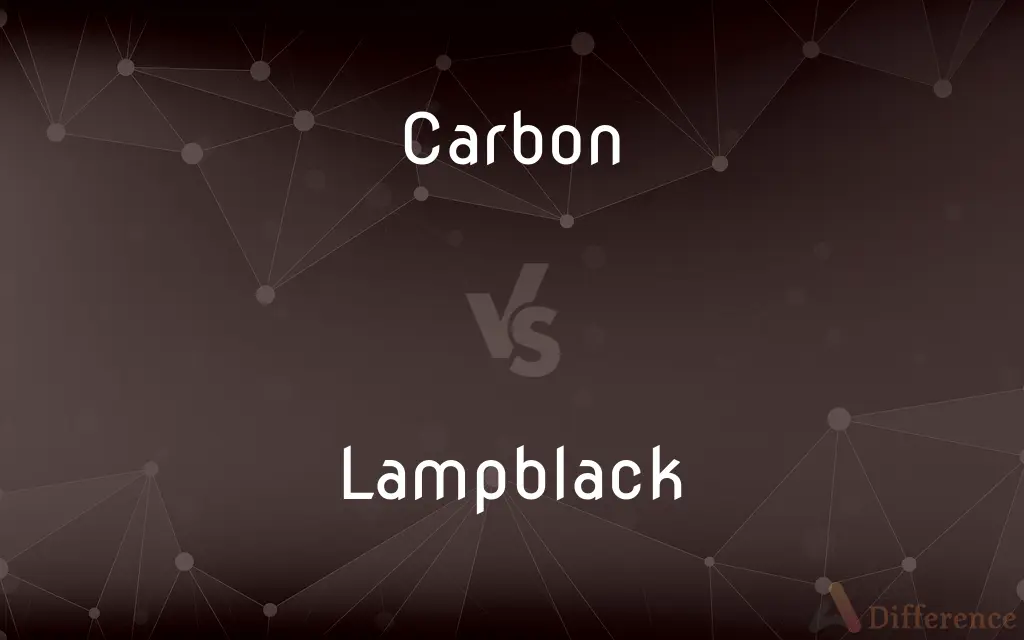Carbon vs. Lampblack — What's the Difference?

Difference Between Carbon and Lampblack
ADVERTISEMENT
Compare with Definitions
Carbon
Carbon (from Latin: carbo "coal") is a chemical element with the symbol C and atomic number 6. It is nonmetallic and tetravalent—making four electrons available to form covalent chemical bonds.
Lampblack
Fine soot collected from incompletely burned carbonaceous materials, used as a pigment and in matches, explosives, lubricants, and fertilizers. Also called blacking.
Carbon
The chemical element of atomic number 6, a non-metal which has two main forms (diamond and graphite) and which also occurs in impure form in charcoal, soot, and coal.
Lampblack
An amorphous form of carbon made from incompletely burned organic matter; used to make pigments and inks.
Carbon
Carbon dioxide or other gaseous carbon compounds released into the atmosphere, associated with climate change
Fossil fuel consumption and carbon emissions continued to rise
The level of carbon in the atmosphere has been consistently rising
ADVERTISEMENT
Lampblack
(transitive) To blacken (something) using this form of carbon.
Carbon
Symbol C An abundant nonmetallic element that occurs in many inorganic and in all organic compounds, exists freely in amorphous, graphite, and diamond forms and as a constituent of coal, limestone, and petroleum, and is capable of chemical self-bonding to form an enormous number of chemically, biologically, and commercially important molecules. Other significant allotropes include fullerenes and nanotubes. Atomic number 6; atomic weight 12.011; sublimation point 3,825°C; triple point 4,489°C; specific gravity of amorphous carbon 1.8 to 2.1, of diamond 3.15 to 3.53, of graphite 1.9 to 2.3; valence 2, 3, 4. See Periodic Table.
Lampblack
The fine impalpable soot obtained from the smoke of carbonaceous substances which have been only partly burnt, as in the flame of a smoking lamp. It consists of finely divided carbon, with sometimes a very small proportion of various impurities. It is used as an ingredient of printers' ink, and various black pigments and cements.
Carbon
A carbon-containing gas, notably carbon dioxide, or a collection of such gases, especially when considered as a contributor to the greenhouse effect
Plans for capturing and sequestering carbon produced by power plants.
Lampblack
A black colloidal substance consisting wholly or principally of amorphous carbon and used to make pigments and ink
Carbon
A sheet of carbon paper.
Carbon
A carbon copy.
Carbon
Either of two rods through which current flows to form an arc, as in lighting or welding.
Carbon
A carbonaceous electrode in an electric cell.
Carbon
(uncountable) The chemical element (symbol C) with an atomic number of 6. It can be found in pure form for example as graphite, a black, shiny and very soft material, or diamond, a colourless, transparent, crystalline solid and the hardest known material. Category:en:Carbon
Carbon
(countable) An atom of this element, in reference to a molecule containing it.
A methane molecule is made up of a single carbon with four hydrogens.
Carbon
A sheet of carbon paper.
Carbon
A carbon copy.
Carbon
A fossil fuel that is made of impure carbon such as coal or charcoal.
Carbon
Carbon dioxide, in the context of climate change. Category:en:Climate change
Carbon neutral
Carbon
A carbon rod or pencil used in an arc lamp.
Carbon
A plate or piece of carbon used as one of the elements of a voltaic battery.
Carbon
(informal) carbon fiber.
Carbon bike frame
Carbon
To cause (someone) to receive a carbon copy of an email message.
When I send it, I'll carbon Julia so she's aware.
Carbon
An elementary substance, not metallic in its nature, which is present in all organic compounds. Atomic weight 11.97. Symbol C. it is combustible, and forms the base of lampblack and charcoal, and enters largely into mineral coals. In its pure crystallized state it constitutes the diamond, the hardest of known substances, occuring in monometric crystals like the octahedron, etc. Another modification is graphite, or blacklead, and in this it is soft, and occurs in hexagonal prisms or tables. When united with oxygen it forms carbon dioxide, commonly called carbonic acid, or carbonic oxide, according to the proportions of the oxygen; when united with hydrogen, it forms various compounds called hydrocarbons. Compare Diamond, and Graphite.
Carbon
A carbon rod or pencil used in an arc lamp; also, a plate or piece of carbon used as one of the elements of a voltaic battery.
Carbon
A sheet of carbon paper.
Carbon
A carbon copy.
The formation of the compounds of carbon is not dependent upon the life process.
Carbon
An abundant nonmetallic tetravalent element occurring in three allotropic forms: amorphous carbon and graphite and diamond; occurs in all organic compounds
Carbon
A thin paper coated on one side with a dark waxy substance (often containing carbon); used to transfer characters from the original to an under sheet of paper
Carbon
A copy made with carbon paper
Share Your Discovery

Previous Comparison
Accent vs. Descent
Next Comparison
Content vs. Syllabus














































